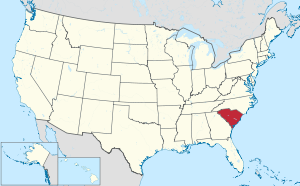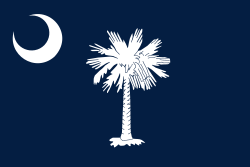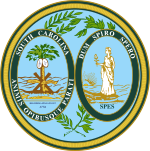South Carolina
South Carolina is a state in the southeast United States. Its capital city is Columbia which with 137,300 people is the largest city in South Carolina by population. The population of the state is about 5.2 million people, ranked 23rd in the United States. South Carolina has an area of 32,030 square miles, making it the 40th largest state in the United States.
South Carolina | |
|---|---|
| State of South Carolina | |
| Nickname: The Palmetto State | |
| Motto(s): Dum spiro spero* (Latin, 'While I breathe, I hope') Animis opibusque parati† (Latin, 'Prepared in mind and resources') | |
| Anthem: "Carolina"; "South Carolina On My Mind" | |
 Map of the United States with South Carolina highlighted | |
| Country | United States |
| Before statehood | Province of South Carolina |
| Admitted to the Union | May 23, 1788 (8th) |
| Capital | Columbia |
| Largest city | Charleston[1] |
| Largest metro and urban areas | Greenville (combined and metro) Columbia (urban) |
| Government | |
| • Governor | Henry McMaster (R) |
| • Lieutenant Governor | Pamela Evette (R) |
| Legislature | General Assembly |
| • Upper house | Senate |
| • Lower house | House of Representatives |
| Judiciary | South Carolina Supreme Court |
| U.S. senators | Lindsey Graham (R) Tim Scott (R) |
| U.S. House delegation | 6 Republicans 1 Democrat (list) |
| Area | |
| • Total | 32,020[2] sq mi (82,932 km2) |
| • Land | 30,109 sq mi (77,982 km2) |
| • Water | 1,911 sq mi (4,949 km2) 6% |
| • Rank | 40th |
| Dimensions | |
| • Length | 260 mi (420 km) |
| • Width | 200 mi (320 km) |
| Elevation | 350 ft (110 m) |
| Highest elevation | 3,560 ft (1,085 m) |
| Lowest elevation (Atlantic Ocean[3]) | 0 ft (0 m) |
| Population (2021) | |
| • Total | 5,190,705[5] |
| • Rank | 23rd |
| • Density | 172.4/sq mi (66.6/km2) |
| • Rank | 19th |
| • Median household income | $50,570[6] |
| • Income rank | 41st |
| Demonyms | South Carolinian |
| Language | |
| • Official language | English |
| Time zone | UTC−05:00 (Eastern) |
| • Summer (DST) | UTC−04:00 (EDT) |
| USPS abbreviation | SC |
| ISO 3166 code | US-SC |
| Traditional abbreviation | S.C. |
| Latitude | 32°2′ N to 35°13′ N |
| Longitude | 78°32′ W to 83°21′ W |
| Website | sc |
| South Carolina state symbols | |
|---|---|
 | |
 | |
| Living insignia | |
| Amphibian | Salamander |
| Bird | Carolina Wren |
| Butterfly | Eastern Tiger Swallowtail |
| Dog breed | Boykin Spaniel |
| Fish | Striped bass |
| Flower | Yellow jessamine |
| Insect | Carolina mantis |
| Mammal | White-tailed deer |
| Reptile | Loggerhead sea turtle |
| Tree | Sabal palmetto |
| Inanimate insignia | |
| Beverage | Milk |
| Dance | Carolina shag |
| Food |
|
| Fossil | Columbian mammoth (Mammuthus columbi) |
| Mineral | Amethyst |
| Rock | Blue granite |
| Shell | Lettered olive |
| State route marker | |
 | |
| State quarter | |
 Released in 2000 | |
| Lists of United States state symbols | |
| South Carolina state symbols | |
|---|---|
 | |
 | |
| Living insignia | |
| Amphibian | Salamander |
| Bird | Carolina wren |
| Butterfly | Eastern tiger swallowtail |
| Fish | Striped bass |
| Flower | Yellow jessamine |
| Insect | Carolina Mantis |
| Mammal | White-tailed deer |
| Reptile | Loggerhead Sea Turtle |
| Tree | Sabal palmetto |
| Inanimate insignia | |
| Beverage | Milk |
| Dance | Carolina shag |
| Food |
|
| Fossil | Columbian mammoth Mammuthus columbi |
| Mineral | Amethyst |
| Rock | Blue granite |
| Shell | Lettered olive |
| State route marker | |
 | |
| State quarter | |
 Released in 2000 | |
| Lists of United States state symbols | |
Other important cities in South Carolina are Greenville, Spartanburg, Anderson, Sumter, and Florence.
Major landforms include beaches, "barrier islands", salt marsh, sandhills Archived 2017-02-18 at the Wayback Machine, rolling piedmont, and the Blue Ridge Mountains. Because of its natural beauty, the state attracts many tourists, especially to Myrtle Beach, Charleston, and Hilton Head Island. South Carolina became a state in 1788. The economy was agriculture-based, known for cotton, rice, indigo, and tobacco by African American slaves. After the American Civil War, the state lost much of its political and economic power. Towards the end of the 20th century, the state began to strengthen its economy and add population. Today, the major industries are tourism, textiles (clothing materials), golf, and manufacturing. South Carolina has the second highest number of workers employed by international companies per capita in the United States.
South Carolina is bounded to the north by North Carolina, to the south and west by Georgia, located across the Savannah River, and to the east by the Atlantic Ocean.
History
changeThe original inhabitants of South Carolina were Native Americans. At least 29 Native American tribes lived in South Carolina. The Native American population declined after the arrival of Europeans.[7]
Farming
changeBefore the Civil War, South Carolina grew a lot of rice. African slaves worked on slave plantations in the state.
Participation In The Civil War & 1876-1966 Segregation
changeThe Civil War
changeSouth Carolina became the first of eleven states to secede from the union, on December 20, 1860, to protest the election of Republican Abraham Lincoln. It joined the Confederacy. The first battle of the Civil War took place at Fort Sumter, in Charleston.
1876-1966 Segregation & Democratic Dominance
changeAfter the Civil War, African-Americans in South Carolina got to vote for some time, but soon black codes were enacted, and white-supremacist groups like the KKK were reborn, restricting African-Americans from voting. South Carolina thus became a Democratic stronghold. In fact, in 1904, Republican Theodore Roosevelt, who was running for president, won less than 5% of the vote in the state. The Democratic candidate won over 95% of the vote. This cult of fear disabled most African-Americans in South Carolina from voting till 1965, when President Johnson signed the Voting Rights Act.
Confederate Flag
changeFor a long time, South Carolina had the Confederate flag hanging over its capital. This is no longer the case.
Famous People
changeU.S. President Andrew Jackson was born in South Carolina.
Related pages
changeReferences
change- ↑ "Population of Cities in South Carolina". World Population Review. 2019. Archived from the original on August 7, 2019. Retrieved August 6, 2019.
- ↑ "United States Summary: 2000" (PDF). United States Census Bureau. 2000. p. Table 17. Archived (PDF) from the original on December 3, 2017. Retrieved January 20, 2012.
- ↑ 3.0 3.1 "Elevations and Distances in the United States". United States Geological Survey. 2001. Archived from the original on October 15, 2011. Retrieved October 24, 2011.
- ↑ Elevation adjusted to North American Vertical Datum of 1988.
- ↑ "U.S. Census Bureau QuickFacts: South Carolina". The United States Census Bureau. Retrieved June 23, 2021.
- ↑ "Median Annual Household Income". The Henry J. Kaiser Family Foundation. Archived from the original on December 20, 2016. Retrieved December 9, 2016.
- ↑ https://www.sciway.net/hist/indians/

